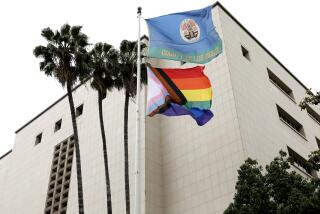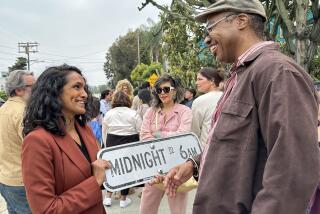HIV Ads Embrace, and Stun, Audience
- Share via
For 20 years, gay men have vigorously fought the contention that HIV is a disease of homosexuals.
But now, one of Southern California’s most influential gay institutions has embarked on a controversial ad campaign with this stark declaration: “HIV is a gay disease.”
For the record:
12:00 a.m. Oct. 26, 2006 For The Record
Los Angeles Times Thursday October 26, 2006 Home Edition Main News Part A Page 2 National Desk 2 inches; 88 words Type of Material: Correction
AIDS prevention ads: A Sept. 30 article in Section A said the L.A. Gay & Lesbian Center had embarked on a controversial ad campaign with this stark declaration: “HIV is a gay disease,” with the tag line “Own It. End It” on billboards and in magazines. The article should have made clear that the print ads, which appeared only in gay magazines, use all of that language; but the billboards -- there are two, in West Hollywood -- say only “HIV,” with the tagline, “Own it. End It.”
With that message and the tag line “Own It. End It” on billboards and in magazines, the L.A. Gay & Lesbian Center says it is trying to reach legions of gay men who have become complacent about HIV and AIDS.
The campaign is an abrupt departure from the years of hard politicking against the idea of AIDS as a gay plague, a characterization that many -- including the Gay & Lesbian Center -- had argued marginalized victims and made it hard to reach others who were at risk, including thousands of minority women who have become infected in recent years.
The ads have stunned some in the gay community and the AIDS services world, who recall the early years of the epidemic, when anti-gay clergy railed against the condition and little money was available for research or prevention.
Some AIDS counselors worry that the campaign could further stigmatize the disease, making women and heterosexual men less likely to come forward.
So much attention is being paid to minority women and others who are at risk that gay men -- who still make up the majority of those infected in the United States and Western Europe -- have developed a false sense of security, backers of the ads say.
The problem of AIDS apathy among gay and bisexual men is of particular concern on the West Coast, public health officials say, where the overwhelming majority of HIV transmission is among men engaging in sex with other men.
In Los Angeles County, about 75% of HIV cases are among men who have had sex with other men.
The L.A. infection count is somewhat at odds with data from other parts of the country -- including several East Coast communities -- where infection is spreading rapidly among women and intravenous drug users.
“A very alarming silence has descended over our community with regard to HIV and AIDS,” said Lorri L. Jean, chief executive of the Gay & Lesbian Center.
“We believe that most people in our community do not understand the degree to which this epidemic continues to be in Los Angeles largely an epidemic among gay and bisexual men,” she said.
The ad campaign has drawn sharp criticism from some in the trenches of the battle against HIV, particularly those who work closely with infected women.
“I applaud the desire to have more personal responsibility in the gay community, but this is not the way to achieve it,” said Michael Weinstein, head of the Los Angeles-based AIDS Healthcare Foundation.
He said that worldwide, it is increasingly heterosexuals who have become ill.
“AIDS is not a gay disease,” Weinstein said. “It’s not an African American disease; it’s not a Latino disease. It is a disease of the immune system.”
Nationwide, gay and bisexual men account for just 45% to 50% of recent HIV transmission, according to the national Centers for Disease Control and Prevention in Atlanta.
Women make up 33% of cases in New York and 27% nationwide. In Los Angeles County, women make up about 12% of the total, according to national and county health statistics, but their number has been increasing.
At particular risk are women and men in immigrant and minority communities, where many men who have had sex with other men do not consider themselves gay and have not disclosed their behavior to their wives and girlfriends.
“This [campaign] is sort of harkening back to the gay community, which is associated with being white and middle-class ... and it excludes, frankly, men who may be at very high risk but don’t identify as being gay,” said Craig Thompson, executive director of AIDS Project Los Angeles.
Activist Cynthia Davis, who has labored for years to ease the stigma of HIV in the African American community, said the Gay & Lesbian Center’s campaign could erase years of progress in a community that is skittish about homosexuality but at high risk for the disease.
“This is ludicrous. It’s ridiculous,” Davis said. “It’s going backward.”
The center’s campaign comes at a time when two powerful public health agencies -- the New York City Department of Public Health and the CDC -- are urging a different approach.
Just last week, the New York department expressly asked outreach agencies not to aim their messages solely at the gay community.
City officials made that recommendation after conducting an extensive study of the sexual behavior of thousands of New Yorkers.
In the study, published last week in the journal Annals of Medicine, the city’s public health officials interviewed more than 4,000 men.
Of the more than 90% who identified themselves as heterosexual, one in 10 later disclosed that they had had sex with a man within the past year.
Lead author Preeti Pathela said that means that any campaign aimed only at men who identify themselves as gay or bisexual could miss as many as 10% of the people it is meant to reach -- and keep their partners in the dark as well.
“There are some people who aren’t even going to read that message, because as soon as they see the word ‘gay,’ they’re going to say, “That’s not me,’ ” Pathela said.
Also last week, the CDC urged doctors to test all adolescents and adults for HIV -- whether or not they identify themselves as gay or bisexual or admit engaging in such high-risk behavior as using intravenous drugs.
Dr. Myles Spar, director of the HIV program at the Venice Family Clinic, a free clinic serving the Westside, said the gay-themed ads in the new campaign should be countered with similar messages aimed at other groups.
“I think it’s fine for the L.A. Gay & Lesbian Center to do this to try to wake up their community, but then similar messages need to be catered to the minority communities that it’s also our disease,” said Spar, who treats a wide variety of people with HIV in his practice, including women, children, gay men and men who identify as straight.
Jean of the Gay & Lesbian Center said her organization’s campaign is not intended to diminish the importance of reaching out to people outside of the gay community with information about HIV and AIDS.
Instead, she said, it is closely targeted to a gay audience in order to provoke discussion and reawaken long-dormant advocacy efforts in that population.
Greg Smiley, a gay man who is public policy director for the American Academy of HIV Medicine, said that at first he was stunned and offended by the ads.
“If some other community except for the gay community said HIV was a gay disease, that would be something we would vilify,” he said.
But then, Smiley said, the concept started to grow on him.
“If I were to design a campaign, that wouldn’t necessarily be the slogan I would come up with ... but letting it sink in a little bit more, it seems like a strong statement to make, and perfectly appropriate,” Smiley said.
“I think we have to all own our own responsibilities and take responsibility for our actions and for our community,” he said.
Others cautioned that the campaign’s message could be interpreted too literally.
“Yes, it’s still a gay disease, and no, it’s not a gay disease,” said Benjamin Perkins, who directs the MALE Center in Boston.
“It’s an unfortunate discussion that pits one group against the other,” Perkins said. “And I don’t think we can afford to go that route.”
More to Read
Sign up for Essential California
The most important California stories and recommendations in your inbox every morning.
You may occasionally receive promotional content from the Los Angeles Times.










